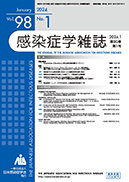
- Issue 2 Pages 134-
- Issue 1 Pages 1-
- |<
- <
- 1
- >
- >|
-
Yumi UCHITANI, Rumi OKUNO, Tsukasa ARIYOSHI, Yuri TABUCHI, Hiroaki KUB ...2024 Volume 98 Issue 2 Pages 134-145
Published: March 20, 2024
Released on J-STAGE: March 20, 2024
Advance online publication: March 05, 2024JOURNAL FREE ACCESSSerotyping, drug susceptibility testing, and penicillin (PCG) resistance genotyping were performed on 780 strains of Streptococcus pneumoniae (398 pediatric and 382 adult strains) isolated from cases of invasive pneumococcal disease (IPD) admitted at medical institutions in Tokyo between 2013 and 2022.
Comparisons of the serotypes of the S. pneumoniae strains isolated during periods into Period 1 (2013-2016), Period 2 (2017-2019), and Period 3 (2020-2022) revealed that from Period 1 to Period 3, the percent isolation of the PCV 13 serotype decreased significantly from 19.4% to 1.2% in pediatric cases, while that of the PPSV 23 serotype decreased significantly from 76.2% to 44.4% in adult cases. In drug susceptibility tests, the PCG resistance rate of the isolated S. pneumoniae strains decreased from 25.5% during Period 1 to 19.1% during Period 2, but increased again to 30.3% in period 3. Similar changes were observed in the percentage of gPRSPs among the PCG-resistant genotypes. Among the non-PCV13 serotypes, serotype 15A, 23A, and 35B strains showed high PCG resistance rates. Serotype 35B strains, which had been increasing since 2020, showed a PCG resistance rate of 69.0% during Period 1 and Period 2 and of 87.5% during Period 3. The erythromycin (EM) non-susceptibility rate decreased slightly from Period 2 to Period 3.
In conclusion, introduction of the vaccine decreased the percent isolation of the vaccine serotypes in both children and adults in Tokyo. The PCG resistance rate of S. pneumoniae strains showed a slight increase, which is attributed to a higher number of non-vaccine serotypes, such as 35B, with high PCG resistance rate.
View full abstractDownload PDF (492K)
-
Hiroyoshi HAYASHI, Takeshi MURAKAMI, Shiori NAKASHIMA, Hirofumi NAKANO ...2024 Volume 98 Issue 2 Pages 146-150
Published: March 20, 2024
Released on J-STAGE: March 20, 2024
Advance online publication: March 05, 2024JOURNAL FREE ACCESSA 72-year-old woman was diagnosed as having diffuse large B-cell lymphoma (DLBCL) in 2017 and showed complete remission (CR) in response to six courses of R-CHOP therapy. In April 2021, when she developed her first disease relapse, she was started on bendamustine-rituximab (BR) as salvage chemotherapy. In June 2021, 23 days after she received her second vaccination for coronavirus disease 2019 (COVID-19) with the BNT162b2 vaccine, she was hospitalized with severe anemia. Blood and bone marrow examinations revealed evidence suggestive of pure red cell aplasia with hemolytic anemia. The anemia resolved rapidly with the administration of prednisolone (PSL), and after two courses of BR, the patient achieved CR again. In March 2022, 29 days after a booster COVID-19 vaccination with the mRNA 1273 vaccine, the patient was re-hospitalized with Coombs-positive autoimmune hemolytic anemia (AIHA), and again showed rapid treatment response to PSL administration. Considering that our patient experienced repeated episodes of hemolytic anemia after COVID-19 vaccinations, we suspected an autoimmune mechanism secondary to COVID-19 vaccination as underlying the development of hemolytic anemia in our patient.
View full abstractDownload PDF (433K) -
Miki KUROKI, Kimitaka AKAIKE, Seiya NAKASHIMA, Akira TAKAGI, Shinji IY ...2024 Volume 98 Issue 2 Pages 151-155
Published: March 20, 2024
Released on J-STAGE: March 20, 2024
Advance online publication: March 05, 2024JOURNAL FREE ACCESSAutoimmune pulmonary alveolar proteinosis (APAP) is known to be associated with a high risk of infections, although the underlying mechanism remains unclear. Herein, we report a case of pulmonary nocardiosis associated with APAP that stabilized after therapeutic whole-lung lavage (WLL). The patient was a 75-year-old man; he was diagnosed as having APAP in 20XX-3 and his condition improved with WLL. A follow-up chest computed tomography (CT) in 20XX-1 revealed a 7-mm nodular shadow in the upper lobe of the left lung, and two CT-guided percutaneous transthoracic needle biopsies (CT-PTNB) were performed, the first in 20XX-1 and the second in 20XX. Although the first CT-PTNB did not yield a conclusive diagnosis, culture of the second biopsy specimen grew Nocardia sp., and we diagnosed the patient as having pulmonary nocardiosis secondary to APAP. He was treated with meropenem for the first 9days andsulfamethoxazole-trimethoprim for 6 months, and follow-up CT revealed a decrease in the size of the nodule. Physicians should bear in mind the possibility of nocardiosis as a complication in patients with APAP even when the disease becomes stable after treatment by WLL.
View full abstractDownload PDF (821K)
-
2024 Volume 98 Issue 2 Pages 156-292
Published: March 20, 2024
Released on J-STAGE: March 20, 2024
JOURNAL FREE ACCESSDownload PDF (1989K)
- |<
- <
- 1
- >
- >|